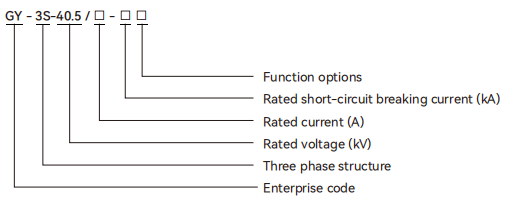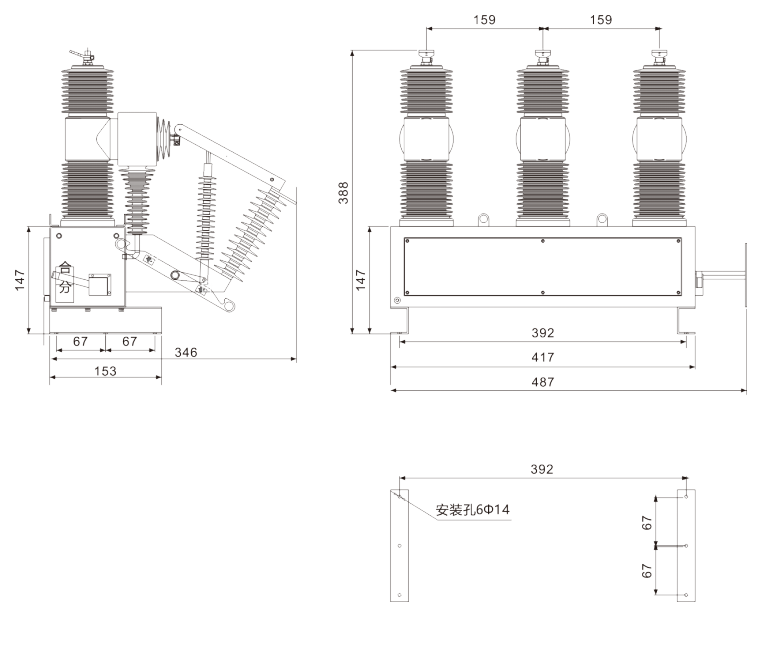The GY-3S-40.5 series outdoor high-voltage vacuum permanent magnet Circuit Breaker is a new generation of column mounted Vacuum Circuit Breakers developed by our company, which integrates advanced technologies from both do008acfstic and international sources,draws on the strengths of various companies, adopts a new design concept, utilizes high-tech methods, and is the latest. mis product can be used as a switch for the main transformer output line of a 35KV substation, as well as a Pole mounted switch for distribution and network. When combined with the controller produced by our company, it can easily achieve control, protection, measurement, and communication. It is the preferred equipment for realizing distribution and network automation and miniaturization of substations.
Main features: using magnetic actuation (permanent magnet mechanism reduces the power of the components significantly, stabilizing and reliable without regular maintenance; using imported outdoor epoxy resin as the external Insulation material, lightweight, with a lifespan of more than 15 years, good weather resistance, oil-free, SF6 free, in line with environmental requirements; short action time,able to quickly cut of faults, convenient and lexible protection coordination; using solar cells or CT as the power source, electric operation can be achieved without external power supply, using a dedicated remote control can achieve remote control operation, without the need for a pole to peform power outage operation; using an integrated design of high-voltage isolation switch, making the structure compact and installation and maintenance vey convenient;
1.Model and meaning

2.Main technical parameters
| Number | Project | Unit | Parameter |
| 1 |
Rated voltage | kV | 40.5 |
| 2 |
Rated current | A | 630 | 1250 |
| 3 |
Rated frequency | Hz | 50/60 |
| 4 |
Rated sho比-circuit breaking current | kA | 31.5 |
| 5 |
Rated peak withstand current (peak) | kA | 63 |
| 6 | Rated sho比-time withstand current (4S) | kA | 31.5 |
| 7 | Rated sho比-circuit closing current (peak) | KA | 95 |
| 8 | Rated sho比-circuit breaking current breaking times | 次/Once | 30 |
| 9 | Mechanical lifespan | 次/Once | 10000 |
| 10 | Power frequency withstand voltage (1min) | kV | 95 |
| 11 | Lightning impulse withstand voltage (peak value) | kV | 125 |
| 12 | Main circuit resistance | μΩ | ≤120 |
| 13 | Current sensor ratio |
| 30~125/5/1 |
3.Environmental conditions for use
 Working environment temperature: -40 ℃~+60 ℃;
Working environment temperature: -40 ℃~+60 ℃;
 Working environment humidity: 0~95%;
Working environment humidity: 0~95%;
 Sunshine radiation in working environment: ≤ 1.1kW/m;
Sunshine radiation in working environment: ≤ 1.1kW/m;
 Wind speed: ≤ 35m/s (equivalent to 700Pa on the suace of a cylinder)Pollution level: Level IV,
Wind speed: ≤ 35m/s (equivalent to 700Pa on the suace of a cylinder)Pollution level: Level IV,
 Ice thickness: ≤ 10mm
Ice thickness: ≤ 10mm
 Seismic intensity: ≤ 8 degrees
Seismic intensity: ≤ 8 degrees
4.Product main structure diagram

Working principle of circuit breaker
A circuit breaker is an essential electrical safety device used to protect an electrical circuit from damage caused by overload or short circuit. It automatically interrupts the flow of electricity when a fault is detected, preventing damage to appliances, wiring, and electrical components.
Basic Function
The primary function of a circuit breaker is to interrupt the flow of electricity in the event of an overload or short circuit. The circuit breaker senses these abnormal conditions and opens the electrical circuit to stop the current, thus preventing further damage. Once the fault is cleared, the circuit breaker can be manually or automatically reset to restore the flow of electricity.
Types of Circuit Breakers
Circuit breakers come in different types, including:
Thermal Circuit Breakers: These use a bimetallic strip that bends when it heats up due to excess current. The bending of the strip causes the breaker to trip, interrupting the current.
Magnetic Circuit Breakers: These use an electromagnet to trip the breaker when the current exceeds a preset limit. The magnetic field generated by the excessive current pulls the contact apart, cutting off the flow of electricity.
Thermomagnetic Circuit Breakers: These combine both thermal and magnetic elements, offering a more comprehensive protection system. They can detect both overloads (using thermal protection) and short circuits (using magnetic protection).
Residual Current Circuit Breakers (RCCB): These detect leakage currents that may occur due to faults in the electrical system. RCCBs help in preventing electrocution by immediately cutting off power when leakage is detected.
Working Mechanism
Overload Protection: When a circuit is overloaded, the excessive current heats up the bimetallic strip (in thermal breakers) or energizes the electromagnet (in magnetic breakers). This heating or magnetization causes the mechanism to trip, breaking the circuit.
Short Circuit Protection: A short circuit occurs when the current bypasses the normal load, usually due to a fault. In magnetic circuit breakers, the rapid increase in current creates a strong magnetic field, which quickly trips the breaker. Thermal breakers might be slower in detecting this, but once the circuit is overloaded, they will trip after a delay.
Resetting: After the circuit breaker trips, it must be manually reset. Some circuit breakers are designed to reset automatically after the fault is cleared, ensuring continuous protection without manual intervention.
Importance of Circuit Breakers
Protection: The main purpose of a circuit breaker is to safeguard electrical systems and prevent fires, equipment damage, and electrical shock hazards.
Efficiency: By detecting faults in the circuit quickly, circuit breakers help in reducing system downtime and maintaining operational continuity.
Compliance: Circuit breakers are crucial for meeting safety standards and electrical regulations in residential, commercial, and industrial settings.
Applications
Residential: In homes, circuit breakers protect household appliances and wiring from electrical faults. They are usually located in the main electrical panel.
Industrial: In industrial setups, circuit breakers are used to protect heavy machinery, control panels, and other equipment from overloads and short circuits.
Commercial: Circuit breakers in commercial buildings ensure that electrical systems remain operational and protected from faults.
Conclusion
Circuit breakers play a critical role in ensuring the safety and longevity of electrical systems. They are designed to detect and interrupt dangerous electrical faults, preventing costly damage and hazards. By understanding their types and how they work, we can appreciate their importance in safeguarding our homes, businesses, and industries.


 Working environment temperature: -40 ℃~+60 ℃;
Working environment temperature: -40 ℃~+60 ℃; Working environment humidity: 0~95%;
Working environment humidity: 0~95%; Sunshine radiation in working environment: ≤ 1.1kW/m;
Sunshine radiation in working environment: ≤ 1.1kW/m; Wind speed: ≤ 35m/s (equivalent to 700Pa on the suace of a cylinder)Pollution level: Level IV,
Wind speed: ≤ 35m/s (equivalent to 700Pa on the suace of a cylinder)Pollution level: Level IV, Ice thickness: ≤ 10mm
Ice thickness: ≤ 10mm Seismic intensity: ≤ 8 degrees
Seismic intensity: ≤ 8 degrees

Comment
(0)